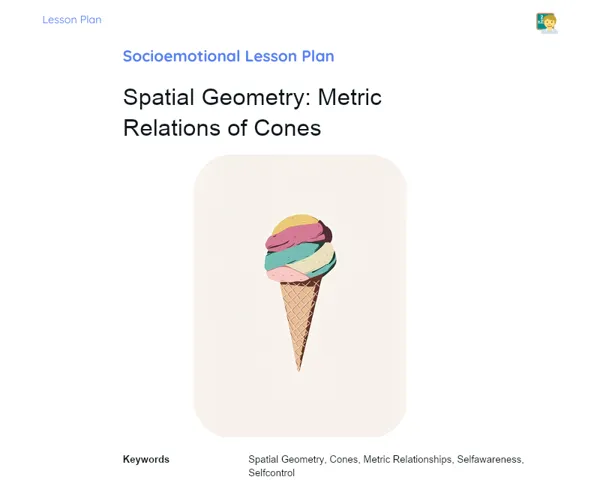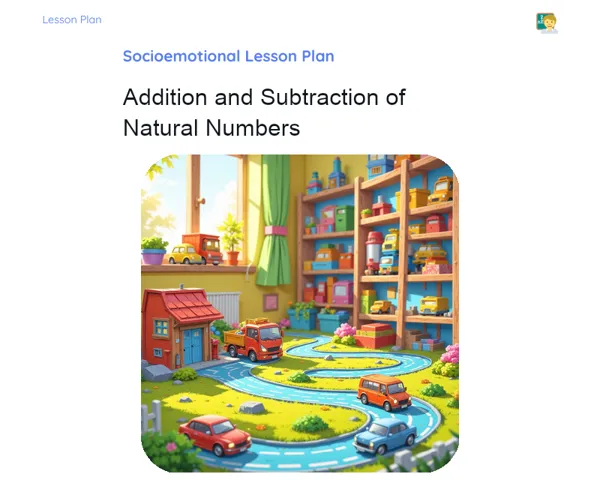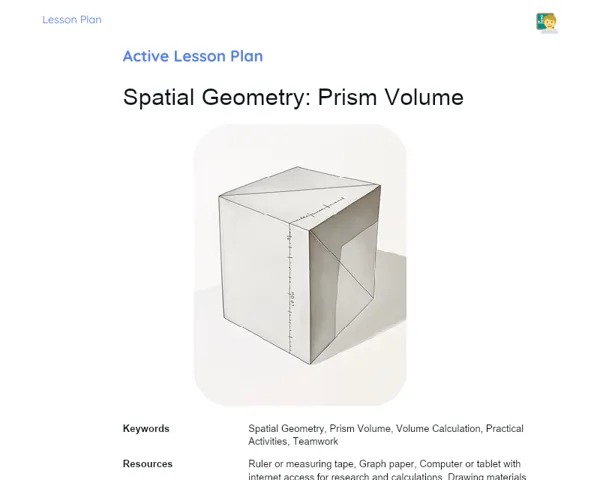Lesson Plan | Lesson Plan Iteratif Teachy | Function: Inputs and Outputs
| Keywords | Mathematical Functions, Inputs and Outputs, Algorithms, Social Media, Gamification, Data Analysis, Digital Engagement, Educational Technology, Collaboration, Problem Solving |
| Resources | Mobile phones, Computers, Internet access, Google Sheets or Excel, Gamification platform (Kahoot! or Quizizz), Presentation materials (poster boards, markers, projectors, etc.) |
| Codes | - |
| Grade | 9th grade |
| Discipline | Mathematics |
Goal
Duration: 10 to 15 minutes
The aim of this part of the lesson plan is to provide clarity on both the primary and secondary objectives, ensuring students understand what is expected of them. This helps in aligning everyone on what they will learn, how they will learn it, and what skills will be developed throughout the lesson.
Goal Utama:
1. Accurately calculate the inputs and outputs of various functions.
2. Solve real-world problems that involve calculating function inputs and outputs.
Goal Sekunder:
- Enhance logical reasoning and problem-solving skills.
- Get comfortable using digital tools to model and solve functions.
Introduction
Duration: 10 to 15 minutes
🎯 Purpose: This segment of the lesson aims to foster a shared understanding among students and spark a discussion that connects them personally to the topic. It seeks to stimulate their curiosity and interest by relating theoretical ideas to their daily lives, making the learning experience more meaningful and relevant.
Warming Up
🔄 Warm-up: Kick off the lesson on Functions: Inputs and Outputs by stressing its importance in mathematics, as well as its practical applications like programming and economics. Ask students to use their phones to find an intriguing fact about functions that they can share with the class. For instance, how functions play a crucial role in social media algorithms, helping to personalize user feeds.
Initial Thoughts
1. What do you understand by 'input' and 'output' in a function?
2. In what day-to-day scenarios can functions be applied?
3. Did anyone come across a captivating example of a function during their search? Please share it with the class.
4. How do you reckon functions are utilized in the technology we interact with daily, such as our smartphones and laptops?
5. Can you think of how a business might use functions to enhance its services?
Development
Duration: 70 to 80 minutes
💡 Purpose: This segment aims to give students practical, contextual opportunities to apply their knowledge of mathematical functions in real and digital contexts. By working in teams and leveraging modern technologies, students cultivate crucial skills in collaboration, problem-solving, and data analysis, making the learning process more vibrant and applicable.
Activity Suggestions
Activity Recommendations
Activity 1 - 📈 Functions in Social Media 🌐
> Duration: 60 to 70 minutes
- Goal: Understand the real-world application of mathematical functions in social media algorithms and how various variables can influence digital outcomes.
- Deskripsi Activity: In this activity, students will evaluate how social media algorithms employ mathematical functions to customize each user's news feed. They will collaborate in groups to model a function that encapsulates the logic behind algorithms on platforms like Instagram or TikTok.
- Instructions:
-
Split students into groups of no more than 5.
-
Each group should select a social media platform that utilizes algorithms for content personalization (like Instagram, TikTok, or YouTube).
-
Students will investigate the criteria these algorithms consider, such as likes, shares, comments, and more.
-
Using their phones, each group will create a simple mathematical function that represents how these variables can affect a post's visibility.
-
They should leverage spreadsheet software (like Google Sheets) to simulate how varying inputs (for example, likes and comments) influence the post's reach (the function's output).
-
Finally, each group will present their findings and their function to the class, detailing how different inputs affect outputs.
Activity 2 - 🎮 Gamification: Function Challenge 🚀
> Duration: 60 to 70 minutes
- Goal: Encourage teamwork and the application of mathematical concepts in a fun and competitive setting, promoting engaging and enjoyable learning experiences.
- Deskripsi Activity: In this fun activity, students will engage in an interactive game where they will solve mathematical problems related to functions in a competitive, gamified environment. They will use an educational app that simulates scenarios where function calculations are key to advancing in the game.
- Instructions:
-
Organize students into groups of up to 5.
-
Guide students to access an educational gamification platform like Kahoot! or Quizizz.
-
The groups will collaborate to tackle mathematical challenges focused on input and output functions, each using a mobile device or computer.
-
Students should deliberate within their groups to solve the presented problems, formulating strategies to achieve the highest possible score.
-
As the teacher, walk around the room to assist and encourage teamwork among students.
-
At the end of the activity, tally the scores of each group and discuss which strategies were most effective, reinforcing the concepts learned.
Activity 3 - 📊 Digital Influencers: Data Analysis 📉
> Duration: 60 to 70 minutes
- Goal: Implement mathematical functions in real data analysis, understanding how to model and anticipate trends based on input and output functions.
- Deskripsi Activity: Students will act as data analysts for digital influencers by utilizing digital tools to assess growth and engagement metrics, modeling these metrics as mathematical functions to foresee future trends.
- Instructions:
-
Form groups of up to 5 students.
-
Each group should choose a digital influencer (either real or fictional) and gather data on their social media growth (like follower count over time, engagement rates, etc.).
-
Using an online data analysis tool (like Google Sheets or Excel), students will represent this data visually with graphs.
-
From the graphs, students will derive a mathematical function that characterizes the growth or engagement curve.
-
They should predict future behaviors of these metrics using the function they created.
-
Each group will then share their analysis and forecasts with the class, explaining their chosen function and showcasing their data.
Feedback
Duration: 20 to 25 minutes
🎯 Purpose: This stage aims to offer time for reflection and collaborative evaluation. The group discussion enables students to share experiences and insights, while the 360° feedback encourages self-reflection and growth. This process solidifies the learned concepts and nurtures a culture of respect and teamwork.
Group Discussion
🗣 Group Discussion: Facilitate a discussion where groups can share what they learned from the activities and the conclusions they drew. Use the following questions to kick off the discussion:
- Introduction: Ask each group to briefly present the activity they completed.
- Process: Inquire about the process they followed to create and model their functions.
- Challenges: Ask about the key challenges they faced and how they overcame them.
- Learnings: Prompt each group to share their most important takeaways.
- Future Applications: Encourage students to think about how they might apply what they’ve learned to other areas outside of social media and data analysis.
Reflections
1. 📊 How can mathematical functions affect content personalization on social media? 2. 🤔 What were the most significant challenges faced while creating and modeling the functions? How did your group tackle them? 3. 🔮 How can you use concepts of input and output functions in other subject areas or in daily life?
Feedback 360º
🔄 360° Feedback: Ask the teacher to complete a 360° feedback session. Each student should provide constructive feedback to their peers who they worked with during the activities. Make sure students address feedback respectfully, using this format:
- Positive Aspect: Each student should mention something positive about a peer’s active participation during the activity.
- Improvement: Each student should suggest an area where their peer can grow.
- Conclusion: Each peer should conclude with a thank-you for the collaboration.
Conclusion
Duration: 15 to 20 minutes
🎯 Purpose: The goal of this stage is to wrap up learnings in a light-hearted and engaging manner, linking mathematical concepts to real life and emphasizing their pertinence. This reinforces the acquired knowledge and inspires students to apply these principles in other academic pursuits and daily activities.
Summary
📚 Summary (Fun Version): Imagine you are digital detectives, uncovering the secrets of function inputs and outputs! Today, we explored the realm of social media algorithms, became proficient in the game of functions, and even transformed into data analysts for influencers! It was a thrilling mathematical journey 🚀💻!
World
🌍 In the World: Today's lesson illustrated that mathematical functions are not merely abstract ideas, but rather powerful tools that significantly impact our digital experiences. From comprehending how our social media feeds get personalized to forecasting an influencer's growth, functions permeate our contemporary lives.
Applications
🔧 Applications: The understanding of input and output functions is essential not just for solving mathematical queries but also for grasping and enhancing the technologies we use in our everyday lives. Recognizing how algorithms operate empowers us to become more informed users and even more effective creators of technology.



